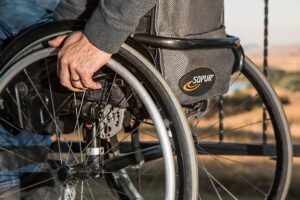Check out our top signs you’ll be able to age in place. It’s easy to start correcting these items if you wish to stay in your own home as you get older.
Want to take steps to age in place? Worried about a loved one?
1. The house provides ease of movement and access.
A home with few stairs (or options to not use or minimize use of stairs) works best for aging in place. Ideally, we would all buy homes with large doorways, no stairs and full accessibility. However, most of us already live in homes that don’t fit this criteria. But, it’s easy enough to make some simple changes to increase ease of movement.
Get a home evaluation. It should focus on falls prevention and ease for daily tasks. Many times, some simple rearranging will improve the flow and safety. There’s often no reason an older adult needs to be climbing into an attic or reaching high into closets. You can download our room-by-room safety review as a start.
2. You keep your house organized and relatively free of clutter.
When we see a cluttered home, we see a fall or accident waiting to happen. Some top culprits include throw rugs, loose cords, and lack of navigable pathways. Poor cleanliness and maintenance can also be health and safety issues. For example, appliances that are never cleaned become fire hazards.Dust and mildew exacerbate breathing issues. The home is also a snapshot of how well the person is managing. But, that can be easily remedied with a little help.
3. You have at least one “aging friendly” bathroom.
How many times have you heard of someone slipping in the bathroom or getting stuck in the tub? Personally, it’s happened to a few of my relatives. EasyLiving gets calls every week from someone who is in the ER or heading to a nursing home after falling in the tub.
Modifying the bathroom can be pretty simple (and inexpensive). You just need to talk to someone who knows how to make sure it’s done right. Simple changes include installing grab bars, adding a raised toilet seat, and non-slip mats. That’s about $65 on Amazon (minus installing the grab bars).
Many homes have one bathroom with a walk-in shower, which is a much better option than a tub. If you only have tubs, you can do a larger remodel or we can suggest other tools and resources to make bathing safer. You’ll recoup the costs as you’re able to age in place.
4. You have an emergency response system.
This is one of the easiest proactive steps you can take. These systems don’t cost a lot. They offer peace of mind knowing you can access help should anything happen.
Why is this different than having a cell/portable phone nearby? Just ask anyone who’s fallen down and couldn’t get to their phone. Also, you may not be able to reach someone who can help you right away. Of course, you can always call “911”. But, the benefit of monitored response systems is that they can talk you through what’s happening and get you the help you need. A neighbor or loved one may be able to assist rather than emergency personnel breaking down the door followed by a trip to the ER. But, they can also get emergency responders there if needed, and help them know what’s been happening while providing you with updates that help is on the way.
These systems typically work on a rental basis. There’s no need to sign a lengthy contract or pay a lot up front. And, your county or local hospital may have a discounted or free option. New technologies offer added features like fall detection, medication reminders and daily checks. Contact us for more information and resources.
5. You engage in daily activity and movement.
If you want to age in place, you shouldn’t stay in one place all day. Your body has to be strong and flexible to get around the house and handle daily tasks. Counteract the loss of muscle and range of motion that comes with aging with daily movement. Being active physically and mentally protects you from many age-related changes.
Read more:
Easy Ways to Live an Active, Long Life
Try something different…fun (sometimes free) fitness ideas!
6. You’re willing to use convenience and support services to age in place.
This might be the number one disconnect between wanting to age in place and doing it. Anyone CAN stay at home their entire life. However, for some people that may require various support services, equipment and the like. Not everyone who says they want to age in place is willing to get the help needed.
And, most importantly, if you’re willing to get a little help now you may be able to avoid needing a lot more later. When we see a client hiring someone to clean his gutters, we see someone who wisely evaluates risks. The couple who gets healthy meals delivered or uses Lyft when going out at night knows the value of investing in themselves.
Check out these Five (Not Just Senior) Services to Make Life Better as You Age.
7. You practice preventative care.
Do you get annual checkups? Are you taking advantage of Medicare screenings?
Spot health issues early with good preventative care. Manage your conditions. Get help coordinating care if you have multiple conditions and providers. Make sure your health records are in order. All these steps will keep you healthier and therefore more independent.
8. Your kitchen doesn’t show these telltale signs.
Is there expired food in the pantry or rotten food in the fridge? Do you have difficulty easily locating and reaching what you need to prepare meals? Is the only food available canned goods, TV dinners and junk food?
The kitchen paints a picture of how well a person is aging at home. Poor diet will lead to a host of problems. And, that poor diet often results from underlying issues with eyesight, strength, memory, etc. or functional challenges with driving or planning.
Here are some easy solutions to remedy poor nutrition for elders living at home. The in-home assessment will also help pinpoint the underlying issues. You care manager can suggest simple ways to make the kitchen more user-friendly along with the best resources.
9. You pass the “medication management” test.
Can you name the medications you’re on and what they’re for? Are you able to explain what you take when? Can you read the medication bottles?
Nearly a quarter of elders admitted to nursing homes have problems managing their medications. More than half of seniors make an error taking medications, often with serious consequences such as hospitalization or death.
Our team suggests solutions tailored to the individual. This may be as simple as setting up a pillbox. Or, a technology solution such as electronic medication systems or apps might help. For some elders, it is well worth enlisting medication management services.
Additionally, we recommend everyone get a regular medication review. Many times, you’re taking redundant or unnecessary medications. Or, even worse, you’ve been prescribed things that interact or could be harmful. And, the doctor or pharmacist may be able to suggest ways to simplify the medication regime.







